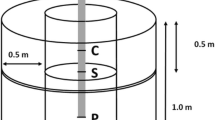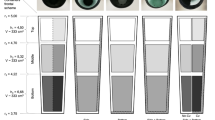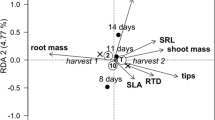Abstract
We revisited a Pinus ponderosa planting 32 years after it was established with one-year-old seedlings grown in copper-treated containers that modified their root systems. This technique was intended to promote more root egress after outplanting from the entire length of the root plug with a goal of providing greater stem stability. After excavating and digitizing the root systems of five treated and five non-treated plants, we observed that regardless of treatment, all trees initiated more roots and accumulated more root volume in apparent response to mechanical stresses invoked by wind and slope, with more roots occurring windward and downslope. Few differences were noted between treatments for root length and volume for either the cage or the entire root system. Trees treated with copper were taller (8%) with stouter taproots (less taper) and less root volume in the lower soil profile than control trees. Although the copper treatment may have induced short-term changes to root system architecture, the long-term, plastic response of this species to mechanical stresses, and the time duration involved, was more critical to the observed expression of traits.



Similar content being viewed by others
Data availability
Data are available at the USFS Research Data Archive (Montagnoli et al. 2021).
References
Arnold MA, Struve DK (1989) Growing green ash and red oak in CuCO3-treated containers increases root regeneration and shoot growth following transplant. J Am Soc Hort Sci 114:402–406
Baddeley A, Rubak E, Turner R (2015) Spatial point patterns: methodology and applications with R. Chapman and Hall, London, pp 608–609
Balisky AC, Salonius P, Walli C, Brinkman D (1995) Seedling roots and forest floor: misplaced and neglected aspects of British Columbia’s reforestation effort? Forest Chron 71:59–65. https://doi.org/10.5558/tfc71059-1
Bolker BM (2008) Ecological models and data in R. Princeton University Press, New York, p 408
Burdett AN (1978) Control of root morphogenesis for improved mechanical stability in container-grown lodgepole pine. Can J Forest Res 8:483–486. https://doi.org/10.1139/x78-072
Burdett AN, Martin PAF (1982) Chemical root pruning of coniferous seedlings. HortScience 17:622–624
Burdett AN, Coates H, Eremko R, Martin PAF (1986) Toppling in British Columbia’s lodgepole pine plantations: significance, cause and prevention. Forest Chron 62:433–439. https://doi.org/10.5558/tfc62433-5
Cameron AD (2002) Importance of early selective thinning in the development of long-term stand stability and improved log quality: a review. Forestry 75:25–35. https://doi.org/10.1093/forestry/75.1.25
Chapman KA, Colombo SJ (2007) Early root morphology of jack pine seedlings grown in different types of container. Scand J for Res 21:372–379. https://doi.org/10.1080/02827580600981888
Chavasse CGR (1978) The root form and stability of planted trees with special reference to nursery and establishment practice. In: Van Eerden E, Kinghorn JM (eds) Proceedings of the root form of planted trees symposium. Joint Report 8. British Columbia Ministry of Forests/Canadian Forest Service, Victoria, British Columbia, pp 54–64
Chiatante D, Scippa GS, Di Iorio A, Sarnataro M (2003) The influence of steep slopes on root system development. J Plant Growth Regul 21:247–260. https://doi.org/10.1007/s00344-003-0012-0
Cooper SV, Neiman KE, Roberts DW (1991) Forest habitat types of northern Idaho: a second approximation. General Technical Report INT–236. US Department of Agriculture, Forest Service, Intermountain Research Station, Ogden, Utah, pp 143. https://doi.org/10.2737/INT-GTR-236
Coutts MP (1983) Root architecture and tree stability. Plant Soil 71:171–188. https://doi.org/10.1007/BF02182653
Danjon F, Fourcaud T, Bert D (2005) Root architecture and wind-firmness of mature Pinus pinaster. New Phytol 168:387–400. https://doi.org/10.1111/j.1469-8137.2005.01497.x
De Zio E, Montagnoli A, Karady M, Terzaghi M, Sferra G, Antoniadi I, Scippa GS, Ljung K, Chiatante D, Trupiano D (2020) Reaction wood anatomical traits and hormonal profiles in poplar bent stem and root. Front Plant Sci 11:590985. https://doi.org/10.3389/fpls.2020.590985
Deljouei A, Abdi E, Schwarz M, Majnounian B, Sohrabi H, Dumroese RK (2020) Mechanical characteristics of the fine roots of two broadleaved tree species from the temperate Caspian Hyracanian Ecoregion. Forests 11:345. https://doi.org/10.3390/f11030345
Di Iorio A, Lasserre B, Scippa GS, Chiatante D (2005) Root system of Quercus pubescens trees growing on different sloping conditions. Ann Bot 95:351–361. https://doi.org/10.1093/aob/mci033
Dumroese RK (2000) Changes in interior Douglas-fir root development in containers after copper and auxin treatments. West J Appl for 15:213–216. https://doi.org/10.1093/wjaf/15.4.213
Dumroese RK, Wenny DL (1997) An assessment of ponderosa pine seedlings grown in copper-coated polybags. Tree Planters’ Notes 48(3–4):60–64
Dumroese RK, Sung S-JS, Pinto JR, Ross-Davis A, Scott AD (2013) Morphology, gas exchange, and chlorophyll content of longleaf pine seedlings in response to rooting volume, copper root pruning, and nitrogen supply in a container nursery. New For 44:881–897. https://doi.org/10.1007/s11056-013-9377-5
Dumroese RK, Terzaghi M, Chiatante D, Scippa GS, Lasserre B, Montagnoli A (2019) Functional traits of Pinus ponderosa coarse-roots in response to slope conditions. Front Plant Sci 10:947.
Ennos AR (1990) The anchorage of leek seedlings: the effect of root length and tensile strength. Ann Bot 65:409–416. https://doi.org/10.1093/oxfordjournals.aob.a087951
Evelyn J (1664) Sylva: or a discourse of forest trees & propagation of timber, vol 1. Reprinted by Arthur Doubleday & Co, Ltd, London
Gardiner B, Berry P, Moulia B (2016) Review: wind impacts on plant growth, mechanics and damage. Plant Sci 245:94–118. https://doi.org/10.1016/j.plantsci.2016.01.006
Godin C, Caraglio Y (1998) A multiscale model of plant topological structures. J Theor Biol 191:1–46. https://doi.org/10.1006/jtbi.1997.0561
Godin C, Costes E, Caraglio Y (1997) Exploring plant topological structure with the AMAPmod software: an outline. Silva Fenn 31:357–368
Gregow H, Laaksonen A, Alper ME (2017) Increasing large scale windstorm damage in western, central and northern European forests, 1951–2010. Sci Rep 7:46397. https://doi.org/10.1038/srep46397
Haase DL, Davis AS (2017) Developing and supporting quality nursery facilities and staff are necessary to meet global forest and landscape restoration needs. Reforesta 4:69–93
Halter MR, Chanway CP, Harper GJ (1993) Growth reduction and root deformation of containerized lodgepole pine saplings 11 years after planting. For Ecol Manag 56:131–146. https://doi.org/10.1016/0378-1127(93)90108-Y
Haywood JD, Sung S-JS, Sayer MAS (2012) Copper root pruning and container cavity size influence longleaf pine growth through five growing seasons. South J Appl For 36:146–151. https://doi.org/10.5849/sjaf.10-051
Hollander M, Wolfe DA (1973) Nonparametric statistical methods. Wiley, New York, pp 115–120
Hurlbert SH (1984) Pseudoreplication and the design of ecological field experiments. Ecol Monogr 54:187–211. https://doi.org/10.2307/1942661
Johnson EA, Miyanishi K (2010) Plant disturbance ecology: the process and the response. Elsevier/AP, Amsterdam, p 720
Jones MD, Kiiskila S, Flanagan A (2002) Field performance of pine stock types: two-year results of a trial on interior lodgepole pine seedlings grown in Styroblocks™, Copperblocks™, or AirBlocks™. BC J Ecosyst Manag 2:12
Kenderes K, Aszalós R, Ruff J, Barton Z, Standovár T (2007) Effects of topography and tree stand characteristics on susceptibility of forests to natural disturbances (ice and wind) in the Börzsöny Mountains (Hungary). Community Ecol 8:209–220. https://doi.org/10.1556/comec.8.2007.2.7
Khuder H, Stokes A, Danjon F, Gouskou K, Lagane F (2007) Is it possible to manipulate root anchorage in young trees? Plant Soil 294:87–102. https://doi.org/10.1007/s11104-007-9232-6
Krasowski MJ (2003) Root system modifications by nursery culture reflect on post-planting growth and development of coniferous seedlings. Forest Chron 79:882–891. https://doi.org/10.5558/tfc79882-5
Lindén A, Mäntyniemi S (2011) Using the negative binomial distribution to model overdispersion in ecological count data. Ecology 92:1414–1421. https://doi.org/10.1890/10-1831.1
Lindström A, Rune G (1999) Root deformation in plantations of container-grown Scots pine trees: effects on root growth, tree stability and stem straightness. Plant Soil 217:29–37. https://doi.org/10.1023/A:1004662127182
Lombardi F, Scippa GS, Lasserre B, Montagnoli A, Tognetti R, Marchetti M, Chiatante D (2017) The influence of slope on Spartium junceum root system: morphological, anatomical and biomechanical adaptation. J Plant Res 130:515–525. https://doi.org/10.1007/s10265-017-0919-3
Marler T, Musser C (2016) Chemical and air pruning of roots influence post-transplant root traits of the critically endangered Serianthes nelsonii. Plant Root 10:21–25. https://doi.org/10.3117/plantroot.10.21
McDonald SE, Tinus RW, Reid CPP (1981) Root morphology control in forest tree seedling containers. In: Proceedings of Intermountain Nurseryman's Association and Western Forest Nursery Association. General Technical Report INT-109. US Department of Agriculture, Forest Service, Intermountain Forest and Range Experiment Station, Ogden, Utah, pp 40–45
Mexal JG, South DB (1991) Bareroot seedling culture. In: Duryea ML, Dougherty PM (eds) Forest regeneration manual. Kluwer Academic Publishers, The Netherlands, pp 89–115. https://doi.org/10.1007/978-94-011-3800-0_6
Montagnoli A, Terzaghi M, Chiatante D, Scippa GS, Lasserre B, Dumroese RK (2019) On-going modifications to root system architecture of Pinus ponderosa growing on a sloped site revealed by tree-ring analysis. Dendrochronologia 58:125650. https://doi.org/10.1016/j.dendro.2019.125650
Montagnoli A, Lasserre B, Sferra G, Chiatante D, Scippa GS, Terzaghi M, Dumroese RK (2020) The response of roots to mechanical stresses in Pinus ponderosa growing on slopes: formation of annual ring eccentricity within the root cage. Plants 9:181. https://doi.org/10.3390/plants9020181
Montagnoli A, Terzaghi M, Chiatante D, Dumroese RK (2021) Characteristics of 32-year-old Pinus ponderosa root systems in northern Idaho, USA. Fort Collins, CO: US Department of Agriculture, Forest Service, Research Data Archive. https://doi.org/10.2737/RDS-2021-0047
Moore JR, Tombleson JD, Turner JA, van der Colff M (2008) Wind effects on juvenile trees: a review with special reference to toppling of radiata pine growing in New Zealand. Forestry 81:377–387. https://doi.org/10.1093/forestry/cpn023
Nicoll BC, Ray D (1996) Adaptive growth of tree root systems in response to wind action and site conditions. Tree Physiol 16:891–898. https://doi.org/10.1093/treephys/16.11-12.891
Pinto JR, Marshall JD, Dumroese RK, Davis AS, Cobos DR (2011) Establishment and growth of container seedlings for reforestation: a function of stocktype and edaphic conditions. For Ecol Manag 261:1876–1884. https://doi.org/10.1016/j.foreco.2011.02.010
R Core Team (2021) R: A language and environment for statistical computing. R Foundation for Statistical Computing, Vienna, Austria. https://www.R-project.org/. Accessed 1 Aug 2021
Regan DJ, Apostol KG, Davis AS (2015) Stocktype influences western white pine seedling size 6 years after outplanting. Tree Planters’ Notes 58(1):37–41
Rellán-Álvarez R, Lobet G, Dinneny JR (2016) Environmental control of root system biology. Annu Rev Plant Biol 67:1–26. https://doi.org/10.1146/annurev-arplant-043015-111848
Ruehle JL (1985) The effect of cupric carbonate on root morphology of containerized mycorrhizal pine seedlings. Can J For Res 15:586–592. https://doi.org/10.1139/x85-095
Sayer MAS, Haywood JD, Sung S-JS (2009) Cavity size and copper root pruning affect production and establishment of container-grown longleaf pine seedlings. For Sci 55:377–389. https://doi.org/10.1093/forestscience/55.5.377
Schelhaas MJ, Nabuurs GJ, Schuck A (2003) Natural disturbances in the European forests in the 19th and 20th centuries. Global Change Biol 9:1620–1633. https://doi.org/10.1046/j.1365-2486.2003.00684.x
Scippa GS, Di Michele M, Di Iorio A, Costa A, Lasserre B, Chiatante D (2006) The response of Spartium junceum roots to slope: anchorage and gene factors. Ann Bot 97:857–866. https://doi.org/10.1093/aob/mcj603
Schluchter MD, Elashoff JD (1990) Small-sample adjustments to tests with unbalanced repeated measures assuming several covariance structures. J Stat Comput Sim 37:69–87. https://doi.org/10.1080/00949659008811295
Seidl R, Dominik T, Kautz M, Martin-Benito D, Peltoniemi M, Vacchiano G, Wild J, Ascoli D, Petr M, Honkaniemi J, Lexer MJ, Trotsiuk V, Mairota P, Svoboda M, Fabrika M, Nagel TA, Reyer CPO (2017) Forest disturbances under climate change. Nat Clim Change 7:395–402. https://doi.org/10.1038/nclimate3303
Soil Survey Staff, US Department of Agriculture, Natural Resources Conservation Service (2013) Official soil series descriptions. https://soilseries.sc.egov.usda.gov/OSD_Docs/V/VASSAR.html. Accessed 15 Nov 2021
Stahel WA (2002) Statistische datenanalyse: eine einführung für naturwissenschaftler. Springer Nature, Vieweg, Braunschweig, Germany
Stein WI (1978) Naturally developed seedling roots of five western conifers. In: Van Eerden E, Kinghorn JM (eds) Proceedings of the root form of planted trees symposium. Joint Report 8. British Columbia Ministry of Forests/Canadian Forest Service, Victoria, British Columbia, pp 28–35
Stokes A, Ball J, Fitter AH, Brain P, Coutts MP (1996) An experimental investigation of the resistance of model root systems to uprooting. Ann Bot 78:415–421. https://doi.org/10.1006/anbo.1996.0137
Stroup WW (2016) Generalized linear mixed models: modern concepts, methods and applications. CRC Press, London
Sun H-L, Lia S-C, Xiong W-L, Yang Z-R, Cui B-S, Yang T (2008) Influence of slope on root system anchorage of Pinus yunnanensis. Ecol Eng 32:60–67. https://doi.org/10.1016/j.ecoleng.2007.09.002
Sung S-JS, Dumroese RK, Pinto JR, Sayer MAS (2019) The persistence of container nursery treatments on the field performance and root system morphology of longleaf pine seedlings. Forests 10:807. https://doi.org/10.3390/f10090807
Svenson SE, Johnston DL, Coy BL (1995) Shoot and root responses of eight subtropical species grown in cupric hydroxide-treated containers. HortScience 30:249–251
Telewski FW, Moore JR (2016) Trait selection to improve windfirmness in trees. CAB Rev 11:1–10. https://doi.org/10.1079/PAVSNNR201611050
Tsakaldimi MN, Ganatsas PP (2006) Effect of chemical root pruning on stem growth, root morphology and field performance of the Mediterranean pine Pinus halepensis Mill. Sci Hortic-Amsterdam 109:183–189. https://doi.org/10.1016/j.scienta.2006.04.007
Watson AJ, Tombleson JD (2002) Toppling in juvenile pines: A comparison of the root system characteristics of direct-sown seedlings, and bare-root seedlings and cuttings. Plant Soil 239:187–196. https://doi.org/10.1023/A:1015036105630
Wenny DL, Dumroese RK (1987) A growing regime for containerized ponderosa pine seedlings. Bulletin 43. University of Idaho, Idaho Forest, Wildlife and Range Experiment Station, Moscow, Idaho, USA, 9 p
Wenny DL, Woollen RL (1989) Chemical root pruning improves the root system morphology of containerized seedlings. West J Appl For 4:15–17. https://doi.org/10.1093/wjaf/4.1.15
Wenny DL, Liu Y, Dumroese RK, Osborne HL (1988) First year field growth of chemically root pruned containerized seedlings. New For 2:111–118. https://doi.org/10.1007/BF00027762
Western Regional Climate Center (2019) Prevailing wind direction. https://wrcc.dri.edu/Climate/comp_table_show.php?stype=wind_dir_avg. Accessed 15 Nov 2021
Westing AH (1968) Formation and function of compression wood in Gymnosperms. Bot Rev 34:51–78. https://doi.org/10.1007/BF02858621
White GC, Bennetts RE (1996) Analysis of frequency count data using the negative binomial distribution. Ecology 77:2549–2557. https://doi.org/10.2307/2265753
Wu TH (1976) Investigation of landslides on Prince of Wales Island. Report 5. Civil Engineering Department, Geotechnical Engineering, Ohio State University, Columbus, Ohio, USA
Yang M, Défossez P, Danjon F, Fourcaud T (2014) Tree stability under wind: simulating uprooting with root breakage using a finite element method. Ann Bot 114:695–709. https://doi.org/10.1093/aob/mcu122
Yang M, Défossez P, Danjon F, Dupont S, Fourcaud T (2017) Which root architectural elements contribute the best to anchorage of Pinus species? Insights from in silico experiments. Plant Soil 411:275–291. https://doi.org/10.1007/s11104-016-2992-0
Zobel RW, Waisel Y (2010) A plant root system architectural taxonomy: a framework for root nomenclature. Plant Biosyst 144:507–512. https://doi.org/10.1080/11263501003764483
Zuur AF, Ieno EN, Walker NJ, Saveliev AA, Smith GM (2009) Mixed effects models and extensions in ecology with R. Springer, New York
Acknowledgements
For their assistance with data collection, we thank Melissa Topping, and Dr. Robert Keefe and his crew at the University of Idaho Experimental Forest. Our gratitude to Dr. Frédéric Danjon of the French National Institute of Agronomic Research (INRA) at Bordeaux for help with digitalization and data processing. Our thanks to Jim Marin Graphics for assistance with visualizations, and to the reviewers and associate editor whose insightful comments helped improve the manuscript. The findings and conclusions in this publication are those of the authors and should not be construed to represent any official U.S. Department of Agriculture or U.S. Government determination or policy.
Funding
This study was supported by the University of Insubria, the University of Molise, the U.S. Department of Agriculture Forest Service (USFS) Rocky Mountain Research Station, and the USFS National Center for Reforestation, Nurseries, and Genetic Resources.
Author information
Authors and Affiliations
Contributions
RKD and DC conceived the research project. RKD provided primary funding. AM, RKD, and DC developed the study plan. GSS provided important insights into the study plan and research process. AM was responsible for field excavations and data collection and analysis. AM and MT equally contributed to the field activities. AM performed the three-dimensional digitalization. BL performed the three-dimensional data arrangement. MA, LSB, and BL analyzed the data. RKD, AM, MA, and DC prepared the manuscript. RKD, LSB, and AM responded to reviewer comments.
Corresponding author
Ethics declarations
Conflict of interest
The authors declare that the research was conducted in the absence of any commercial or financial relationships that could be construed as a potential conflict of interest.
Consent for publication
All authors have read this manuscript and consent to its publication in New Forests.
Additional information
Publisher's Note
Springer Nature remains neutral with regard to jurisdictional claims in published maps and institutional affiliations.
Rights and permissions
About this article
Cite this article
Dumroese, R.K., Terzaghi, M., Acevedo, M. et al. Root system architecture of Pinus ponderosa three decades after copper root pruning in a container nursery. New Forests 53, 983–1001 (2022). https://doi.org/10.1007/s11056-022-09904-2
Received:
Accepted:
Published:
Issue Date:
DOI: https://doi.org/10.1007/s11056-022-09904-2




